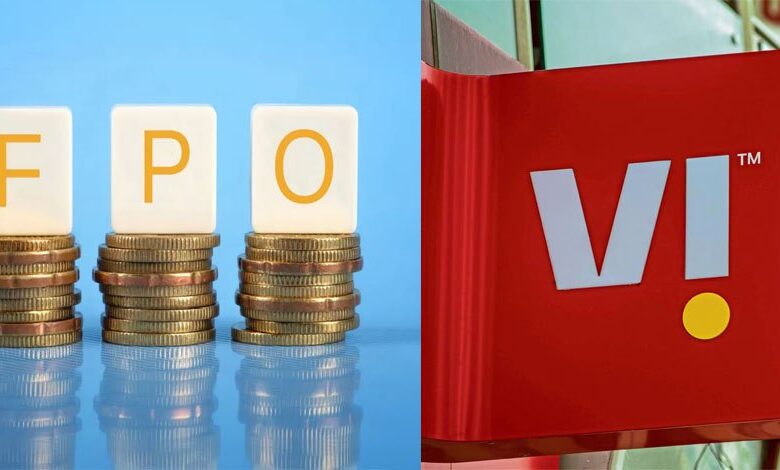Vodafone Idea FPO; Is Rs 18,000 Crore Enough To Stall The Falling Star?
The Vodafone Idea FPO is crucial for the company, even as investors await its impact on the struggling telecom giant. With the subscription period closed and allotment status set to be finalized today, questions about whether the infusion of Rs 18,000 crore will be sufficient to turn the tide for Vodafone Idea amidst its challenges of market share erosion and towering debt.

The Vodafone Idea FPO share allotment status will be determined today, on Tuesday, April 23.
The FPO, from the country’s third-largest telecom operator, opened for subscription on Thursday, April 18, and concluded on Monday, April 22.
On the final day, the subscription status stood at 6.36 times, with qualified institutional buyers oversubscribing by 19.3 times their allotted part.
Today, Vodafone Idea’s share price on the BSE is trading 2.64% higher at ₹13.23 each.

Vodafone’s Loosing Grip
Despite expansion efforts, the challenge of a shrinking market share and high debt might hinder long-term revival.
As Vodafone Idea struggles to retain its market position with mounting debt, the critical lifeline is cash—lots of it.
But can Rs 18,000 crore suffice to resuscitate a financially strapped VI? Possibly not.
While this amount could significantly bolster VI’s cash flow, it might not be enough to avert an impending cash crunch.
Vodafone idea aims to raise Rs 18,000 crore through a follow-on-offer (FPO), marking India’s largest FPO, open for subscription from April 18 to April 22.
The price band for this offering is set between Rs 10 and Rs 11 per share, representing a discount compared to Monday’s closing price of Rs 13.16.
Post-issue, Rs 18,000 crore represents approximately 25 percent of the total market capitalization at Rs 11 per share. Despite recent momentum, primarily attributed to the revival plan, the stock’s performance has remained uncertain.
According to analysts Aditya Bansal and Anil Sharma from Kotak Institutional Equities, while the FPO might provide a short-term boost to VI’s prospects, its long-term revival hinges on government support.
They view the fundraising plan as a step forward, albeit overdue. However, the FPO is expected to mitigate the network coverage gap and enhance competitiveness against industry peers to some extent.
Bansal and Sharma anticipate that with Vodafone Idea’s bank debt significantly reduced, the company stands a better chance of securing additional funding from banks.
However, they do not foresee Vodafone Idea gaining substantial market share compared to its competitors. Their concerns extend to the potential for significant equity dilution due to the conversion of government dues.
In a worst-case scenario, they suggest that the Government of India could end up owning over 80 percent of VI on a fully diluted basis, which would limit any meaningful upside for minority investors in VI, according to Bansal and Sharma.
While a successful fundraising plan would enable Vodafone Idea to bolster its network capital expenditure and narrow the gap with competitors in terms of 4G coverage and 5G rollouts, obstacles persist.
The company has been struggling with multifaceted challenges, so merely raising funds may not suffice to shield the telecom company from uncertainties, especially in a market dominated by formidable rivals like Bharti Airtel and Reliance Jio.
Saurabh Handa and Prerna Goenka, analysts at Citi Research, anticipate that a potential tariff hike post-elections, coupled with the prospect of adjusted gross revenue (AGR) relief, could substantially enhance Vodafone Idea’s cash flow position.
Nonetheless, they caution that VI might still encounter a cash shortfall starting from the second half of FY26 once the ongoing moratorium on the government’s AGR and spectrum repayments expires.
This uncertainty looms large, particularly concerning both cash flow and equity dilution, unless the government opts to convert these dues into equity. As of October last year, VI reportedly owes Rs 58,254 crore in AGR dues, of which it had paid Rs 7,854 crore.
Handa and Goenka outline two potential scenarios regarding VI’s cash flow – one scenario assumes higher tariff hikes, conversion of government dues to equity, and some relief on the AGR front, while the other scenario adopts a more conservative approach on all these fronts.
The significant increase in capital expenditure projected over the next few years under both scenarios bodes well for Indus Towers, an indirect wholly owned subsidiary of Vodafone Group.

What potential improvements lie ahead with the infusion of funds?
A substantial portion of the funds raised through the FPO is earmarked for capital expenditure (capex), network expansion, and the deployment of 5G infrastructure.
Vodafone Idea anticipates allocating approximately Rs 12,750 crore towards procuring equipment to bolster its network infrastructure expansion efforts.
This includes establishing new 4G sites, enhancing the capacity of both existing and new 4G sites, and setting up new 5G sites, as outlined in its Red Herring Prospectus (RHP).
VI’s strategic plan entails directing 70 percent of the FPO proceeds towards enhancing 4G coverage (26,000 sites), 4G capacity (40,800 sites), and facilitating the rollout of 5G technology (22,000 sites).
Additionally, Rs 2,175 crore will be allocated for settling deferred payments for spectrum to the Department of Telecommunications (DoT) and for Goods and Services Tax (GST).
The remaining balance of Rs 18,000 crore will be utilized for general corporate purposes. Analysts Bansal and Sharma assert that bolstered 4G coverage could help VI stem market share losses in the short term.
In conjunction with the FPO, VI’s board has greenlit a preferential share issuance to raise Rs 2,075 crore from an entity within the Aditya Birla Group (ABG). VI disclosed in a notice to the stock exchange on April 13 that shares will be issued to Oriana Investments Pte Ltd at Rs 14.87 per share.

Challenges – a declining market share and mounting debt
Despite these initiatives, revitalizing VI’s dwindling market share remains an uphill battle. Since the merger, VI has witnessed a 19 percent decline in market share, largely attributed to inadequate network investment.
Although analysts at Kotak Institutional Equities anticipate VI bridging the gap in 4G network coverage and partially mitigating market share losses, the disparity in 5G coverage compared to larger competitors is expected to persist.
Moreover, VI’s peers stand to gain more from potential tariff hikes and can outspend VI in customer acquisition efforts, potentially hindering VI’s ability to make substantial market share gains against Bharti and Reliance Jio.
Also, the telecom operator’s debt is escalating at an alarming pace, amounting to Rs 2.1 trillion owed to the government, a substantial portion of which is currently under moratorium until the first half of FY26.
By the second half of FY26, Vodafone Idea (VI) faces repayments totaling Rs 29,100 crore, with annual obligations amounting to Rs 43,000 crore over FY2027-31.
According to Bansal and Sharma, the anticipated fundraising and potential tariff adjustments may enhance VI’s financial outlook. However, they express skepticism regarding VI’s ability to generate sufficient cash EBITDA to meet the significant annual dues owed to the government.
While the possibility of extending the moratorium, obtaining partial relief on Adjusted Gross Revenue (AGR) dues, and further government assistance exist, completely writing off government dues for a specific company presents a formidable challenge.
Bansal and Sharma anticipate VI progressively converting a substantial portion of the government dues into equity over time, potentially resulting in substantial equity dilution for VI’s non-government investors.
The Last Bit, In a worst-case scenario where 100 percent of government dues are converted into equity at Rs 10 per share, the government’s stake could surge to 81 percent.
In comparison, the existing promoters’ stake could diminish to 9 percent (compared to the current 49 percent and 38 percent post-fundraising, respectively).
While, Non-promoter investors’ stake could decline to 9 percent (down from the current 16 percent and 36 percent post-fundraising, respectively).






